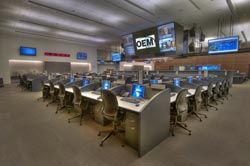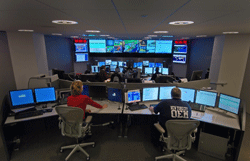- NEW YORK, NY-There is a unified entity that monitors New York City's many entry points and its seemingly countless array of intersections, infrastructure elements, and even weather conditions. It's called the Office of Emergency Management (OEM), and it has a new home based on a highly technological foundation.
Multiple audio, video, and computer tie lines were installed to link the EOC to the Situation Room and Watch Command (pictured).
This project is not just about technology or architecture, however. The occasion for OEM's expansion into a new facility was borne of tragedy, subsequent to the loss of its original headquarters in the attacks of September 11, 2001. In light of these circumstances, the new OEM headquarters in Brooklyn was built with the aim of looking forward in order to build a stronger New York.
Among the foremost in priorities for the refitting of an existing Brooklyn office building were two future-oriented notions. First, the new facility was built for technology and at its core is an integrated audiovisual, data/voice, and acoustics design by Shen Milsom & Wilke (SMW). Second, the architecture firm of Swanke Hayden Connell Architects (SHCA) had a vision of sustainability for this iconic structure, a fact that is expected to make this the first LEED Silver-rated building owned by the city of New York.
These factors made for a prolific collaboration between the audiovisual consultant and the architect on the project, a working partnership which was founded when the original OEM headquarters was completed in the World Trade Center in 1999. "This is a 66,000-square-foot building," observed Steve Emspak, a partner with SMW. "A lot of time and effort went into infrastructure planning in order to develop the most cost-effective solution that will retain value into the future.
"It's impossible to do something like that unless you have very close integration between the technology disciplines right from the beginning," noted Robert Klotzbach, a senior associate with SMW responsible for the design and engineering of the OEM project.
The teamwork aspect of this project was two-fold. Within the SMW organization there were several disciplines that came together to make the project a success, and on the job site, coordination between the audiovisual integrator SPL Integrated Solutions and all the other trades on the project was critical. In addition to the weekly construction meetings, technology meetings were also held weekly so that SMW could connect with the low-voltage contractors, the architect, the city of New York, and OEM end-users all in one sitting. "Those meetings were key to the implementation process," Emspak said. "We were resolving issues at the table, not going back in and doing a remedial fix later on."

New York's OEM was built for technology, and at its core is an integrated audiovisual, data/voice, and acoustics design by Shen Milsom & Wilke.
Topping the list of challenges in the design and implementation of the AV technology was the provision of systems through which information from thousands of sources could easily be accessed and displayed. Those sources include television, radio, and internet content, as well as government feeds and countless other data sources. Most importantly, regardless of whether OEM staff was in a routine watch mode or in an elevated alert status, they had to be able to hear and see relevant data and communications without interference from the background noise inherent to the open-air environment of the headquarters' command center spaces.
In keeping with the architect's vision for a "green" facility, the new OEM headquarters was built into an existing 1954 office building, with an 8,000-square-foot addition. Part of the gut renovation involved raising the roof on the third floor to accommodate the two-story open-plan Emergency Operations Center (EOC), which is flanked by Watch Command and a Situation Room, both of which have glass walls overlooking the EOC."
Having worked out of a temporary headquarters since 2001, OEM had some advanced expectations for its new home. "The city was looking for a larger, more flexible space," Emspak said. "They wanted improved sight lines and improved communication. When you put 100-plus people in a room, it's a dynamic environment with a lot of activity, talking, telephones-just a lot of background noise. They really needed to address that in a better fashion than they had in the past, so acoustics and sound reinforcement played a key role within the EOC."
Eight EAW loudspeakers connected via a Biamp audio distribution and powered by QSC amps make it possible to hear what OEM users are saying into any of the various microphones sprinkled throughout the sound field at various city, state, and federal organizations' stations.
The visual aspect of the room is centralized around what has been dubbed the EOC's "scoreboard." In an unusual departure from the usual video-wall setup, the primary video displays are actually two mirrored sets of two 160-inch rear-projection screens butted up against each other. Fed by four Christie Digital 8000-lumen 16 x 9 projectors, the screens display a vast array of images thanks to two RGB Spectrum Media Wall 2000 multi-image processors. As if this wasn't enough, 84-inch plasma displays flank the scoreboard for additional visual data. Around the perimeter of the EOC, eight 61-inch NEC plasma displays can mirror the images from the central displays or display unique images.
A Crestron control system accessed via two 15-inch touchpanels with annotation capabilities and carefully programmed presets not only provides streamlined access to all the content and displays, but also figures in lighting level and other ergonomic concerns for a facility where users may work long hours. Elexos performed the advanced Crestron programming that makes it possible for OEM users to walk in and intuitively utilize the system, easily managing the huge number of inputs and video display options.
All the routers and switchers for the EOC are housed in the Audiovisual Data Center, which also supports the Situation Room and the Watch Command. Eight dedicated PCs provide computer data and graphics imaging for primary, secondary and tertiary EOC display screens. Multiple audio, video, and computer tie lines were installed to link the EOC to the Situation Room and Watch Command. Signals generated in any one of these strategic spaces may be shared with all others to aid in the timely dissemination of vital information. Endeleo provides transport for television signals throughout the common areas.
Connecting The Dots
It is appropriate that a facility designed for multiple agencies' collaboration was built by a well-orchestrated coalition of trades. SPL's Larry Politi was project manager for the OEM installation, and saw to it that the specs came to fruition with all the additional information gathered at the weekly technology and construction team meetings. SPL's numerous offices came together to provide the required engineering talent and technical expertise. Finally, It was up to SPL's operations manager, Patrick Corcoran, to ensure that the equipment arrived at the facility in a highly logistical manner, as there was limited storage space available.
One of the most remarkable attributes of the EOC, the "scoreboard," proved to be one of the most significant challenges on the project. The enormous rear-projection screens had to be brought in through the side of the building, and the enclosure itself was designed to be as light as possible so as not to overwhelm the roof trusses.
"It is a little out of the norm to use a large display like this, many times it's a number of smaller displays," Klozbach commented. "It's not something that might occur to a designer right off the bat-in fact it didn't occur to us right off the bat either. But the resulting design was very cost-effective and it minimized the weight that we had hanging out there."
With so many inputs routed to a limited number of unique screens, the OEM headquarters is an interesting representation of the city it protects. "They're monitoring everything," Robinson said. "How do you monitor a city this size and all of its potential connections for data that is important to all these various organizations. Quite literally, it's one building that has every possible connection to every possible line of communication."










